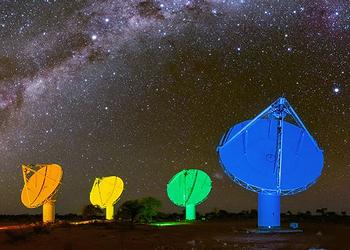
CANBERRA, Australia, February 20, 2019 (ENS) – Australia’s national science agency, CSIRO, has lit up its Australian Square Kilometre Array Pathfinder radio telescope as a rainbow for Sydney Gay and Lesbian Mardi Gras 2019.
Six of the 12-metre wide antennas located in remote Western Australia each reflects a color of the rainbow against the backdrop of the Milky Way.

It was created to mark CSIRO’s inaugural participation in the Mardi Gras Parade. Fifty CSIRO staff will march in the parade on March 2 holding a giant double helix to represent DNA, celebrating the organization’s commitment to diversity.
The idea of a rainbow originated from the rainbow flag, known as the gay pride flag or LGBT pride flag, a symbol of lesbian, gay, bisexual and transgender pride and LGBT social movements. Rainbows also symbolize peace.
The colors depict the diversity of the LGBT community, as the flag is often used as a symbol of gay pride during human rights marches. While this use of the rainbow originated in California’s San Francisco Bay Area, the rainbow flag is now used worldwide, but the rainbow has never before been used on telescopic antennas.
According to Diversity Council Australia, people who work in an inclusive team are nine times more likely to innovate, and 10 times more likely to be highly effective than workers in non-inclusive teams.
CSIRO Chief Executive Dr. Larry Marshall said CSIRO is highlighting the importance of diversity not just at the agency but also the critical role diversity has played in science and innovation generally.
“Diversity is in our DNA, and our LGBTQI+ community is a crucial part of CSIRO’s DNA,” Marshall said. “It is only through an inclusive and diverse culture that we can imagine, invent, and innovate solutions to Australia’s greatest challenges.”
“At the CSIRO we want people to bring their whole selves to work, to create a healthier, happier workplace where people are truly empowered and free to innovate and shape the future,” Marshall declared.
Insect expert Dr. Bryan Lessard, aka Bry the Fly Guy, is among the 50 CSIRO marchers taking part in the colorful parade.
“From naming a bootylicious insect ‘Beyonce’ to preaching the wonders of flies on the radio and TV, I’ve had the privilege of doing some pretty fabulous things over the course of my career, and representing CSIRO at Mardi Gras will be right up there,” Dr. Lessard said.

Dr. Sarah Pearce, deputy director of CSIRO Astronomy and Space Science, or CASS, founded CASS’s Diversity Committee in 2014 and is also an ally of the LGBTQI+ community.
“We really value the diversity of our people, and how they bring different perspectives to innovate and shape the future for everyone,” Dr. Pearce said.
“As a national research facility, ASKAP is used by a diverse group of astronomers from right around the globe.”
CSIRO has an active Diversity and Inclusion program which includes participation in gender equity initiatives such as the SAGE pilot program and Male Champions of Change membership, implementation of a Reconciliation Action Plan, and an active Pride@CSIRO network.
The Australian Square Kilometre Array Pathfinder (ASKAP) is located at the Murchison Radio-astronomy Observatory about 800km (500 miles) north of Perth on Australia’s west coast.
ASKAP is the world’s fastest survey radio telescope. Designed and engineered by CSIRO, ASKAP is made up of 36 dish antennas, spread across a circle six kilometres in diameter, that work together as a single instrument called an interferometer.
The key feature of ASKAP is its wide field of view, generated by its unique phased array feed receivers. Together with specialized digital systems, the phased array feed receivers create 36 separate simultaneous beams on the sky which CSIRO says “are mosaicked together” into a large single image.
ASKAP is ideally situated for listening to faint “whispers” from space. Its low levels of radio-frequency interference and sophisticated on-site infrastructure are essential for exploring the origins of the Universe, CSIRO explains.
CSIRO says, “We acknowledge the Wajarri Yamatji people as the traditional owners of the Murchison Radio-astronomy Observatory site, which is home to the Australian Square Kilometre Array Pathfinder radio telescope.”
Copyright Environment News Service (ENS) 2019. All rights reserved.
© 2019, Environment News Service. All rights reserved. Content may be quoted only with proper attribution and a direct link to the original article. Full reproduction is prohibited.
